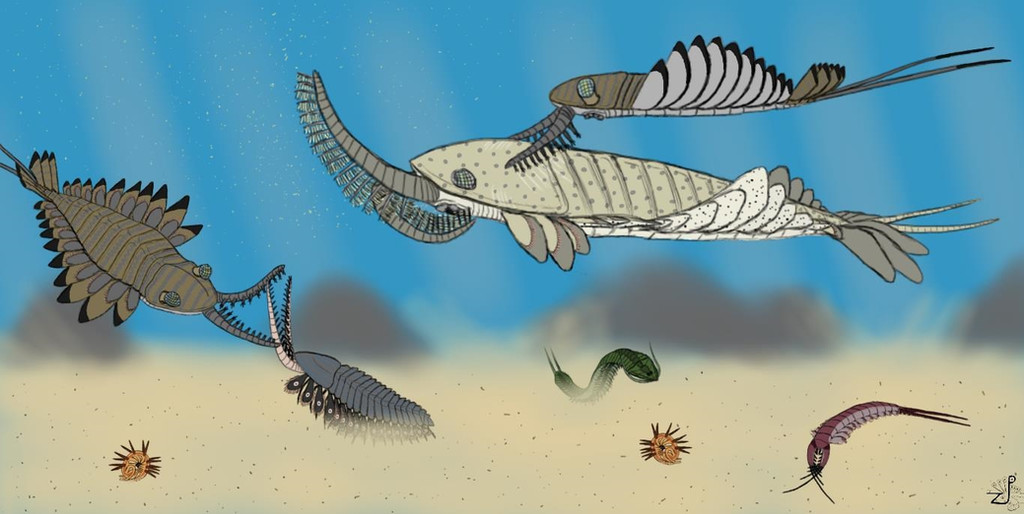HOME | DD
 ZoPteryx — The Odd Life of Sirius Passet
ZoPteryx — The Odd Life of Sirius Passet

Published: 2014-04-09 00:53:42 +0000 UTC; Views: 3561; Favourites: 79; Downloads: 7
Redirect to original
Description
A scene depicting some of the peculiar organisms know to occur in the Sirius Passet Laggerstatte of northern Greenland which formed during the Cambrian period some 518 million years ago, making it about 10 million years older than the famous Burgess Shale.In the water column, a Tamisiocaris uses its specialized "great appendages" to filter the water of microorganisms; at 70 cm in length, it's the largest filter feeder the Earth has seen thus far. It is harassed by one of its cousins, a small Anomalocaris, who's great appendages are armed with wicked spines for seizing prey. A large Anomalocaris can reach almost 2 meters in length, making it a very serious threat to all life, but this individual is young and its attacks amount to little more than scratches on the Tamisiocaris' exoskeleton. At the left, another young Anomalocaris has found a much more manageable meal, a Kiisortoqia. Kiisortoqia is another relative, but considerably more primitive; it stills bears walking legs in addition to its "gill-fins" and it lacks eyes. Blind, the Kiisortoqia's only defense is to raise its barbed great appendages and attempt to ward off the attack using its sense of touch; understandably, it stands little chance against a sighted super predator like Anomalocaris. Sensing the vibrations of the looming threats, a pair of Hallucigenia curl into balls to reveal their defensive spines. These would be of little use against Anomalocaris, but fortunately, Hallucigenia is a bit too small to be on the menu. Other creatures take a more direct approach to avoiding danger; the elongated trilobite Kleptothule, normally quite slow, begins undulating its body in an attempt to swim away from the scene. It stirs up sediment in the process, acting as a smoke screen to its escape. At the lower right is another peculiar anomalocarid-type creature, the primitive Kerygmachela. Like Kiisortoqia, it has both walking legs and gill-fins, and is totally blind. Unlike Kiisortoqia, it prey on very small game, feeling about in the sediment using the antennae-like extensions of its great appendages. This individual appears to have captured something worth eating.
Eyesight would prove to be major advantage in the evolutionary arms race of predator and prey, allowing creatures to react to threats before they came in contact with them. Soon, sighted organisms will dominate the oceans, with only the most well protected or fastest reproducing unsighted organisms clinging on. But for a brief time in the Cambrian, the two groups stood equal to one another, prompting an evolutionary radiation unparalleled in times since: the Cambrian Explosion.
.....................................................................................................................................................................................................
Note: Anomalocaris is not known from Sirius Passet, but it is known from formations both older and younger.
A few days late, but better late than never! Tried to give it some depth and make it a little silty in places.
Made in Sketchbook Express
Related content
Comments: 16

That surely was one weird era of our planet.
Wonder how life would have been today if things would have went totally different and these things would have taken the land faster and vertebrates never appeared ?
👍: 0 ⏩: 1

It's difficult to say. It'd probably be world of giant invertebrates and maybe even bigger echinoderms!
👍: 0 ⏩: 1

Yeah, I think so to, with giant armored crustaceans replacing large herbivores, large alien-like predatory creatures and also maybe whale sized flying beast and trees that are more animal then plant !
Somewhat similar scenario happens also in a book called ,,Fragment" a.k.a ,,Henders Island"
👍: 0 ⏩: 0

Hmm, I never thought of Hallucigenia rolling up before. I suppose it makes sense - although mightn't burying themselves in the seabed with only the spines protruding work better?
👍: 0 ⏩: 1

That could definitely be a resting posture, though I'm not sure they'd be able to bury themselves quickly at a moments notice. I imagined them rolling up into a ball not only to reveal their spines, but also to roll away from the danger with the current.
👍: 0 ⏩: 0

ALso, Tamisiocaris' appendages actually WERE segmented, so your reconstruction is correct.
👍: 0 ⏩: 1

Sweet! You actually beat me to the Tamisiocaris reconstruction. Love your take on it, though
👍: 0 ⏩: 1

I love everything from the Cambrian. Nice color choices, muted but realistic.
👍: 0 ⏩: 1

Thank you! Yeah, Cambrian life is so whacky and awesome!
👍: 0 ⏩: 0





























